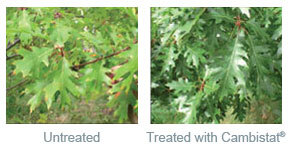Tree and Shrub Growth Regulators
Tree and Shrub Growth Regulators
Tree Growth Regulators and Shrub Growth Regulators slow branch tip growth of trees and shrubs while benefiting plant health, reducing pruning costs and frequency. Tree Growth Regulators are used to re-allocate tree resources, putting more reserves into the tree’s rainy day resource account and aiding trees in the aging process, damage recovery, and drought tolerance. Tree Growth Regulators can stimulate adventitious buds in trees such as pin oaks which can help to centralize weight, growth, and photosynthate production in senescence. Arbor Doctor sometimes uses tree growth regulators to increase resistance in susceptible trees to bacterial fireblight disease.
Growth Retardants: A Promising Tool for Managing Urban Trees
Growth regulators have many benefits in the landscape:
Twenty-five years ago, growth regulators were mostly utilized by large utility companies to keep trees out of power lines, but largely ignored by tree health professionals. Today, growth regulators are better understood, widely used, and benefiting trees in ways beyond growth regulation alone, including:
- Drought Tolerance
- Greener Leaves
- Disease Resistance to diseases such as bacterial fireblight.
- Root Growth
When growth regulators are applied to the root zone of a tree or shrub value can be added by:
- Extending the time between trimmings, which helps maintain a tree’s size for at least 3 years.
- Maintaining a more moderate size tree canopy, providing better biomechanical balance.
- Creating healthier trees by increasing root hair growth.
- Increasing drought tolerance.
- Redistributing carbohydrates (trees make their own food through photosynthesis) from growth to storage and fine roots.
- Extending the lifespan of trees by reducing stress from limited root space.
- Extending the serviceable life of a tree planted too close to a building or utility wires.
- Moderating mild micronutrient deficiencies.
- Allows the tree to grow steadily, requiring less pruning and providing added tolerance to certain diseases and insects.
Note: The material above is from the manufacturers of Cambistat. The active ingredient in both Cambistat and Shortstop is Paclobutrazol.
How does it all work?
All trees and shrubs contain a growth hormone called Giberellic Acid, or GA for short. GA is principally responsible for cell expansion and to a lesser extent cell division (the process of branch growth). The active ingredient of the growth regulator reduces the effects of GA on the cells.
The direct effect is a dramatic reduction in vegetative growth, especially internodal elongation, which means the size of treated trees can be effectively regulated by 40-60% for up to 3 years. Trees may also show fewer effects from a range of plant diseases and micronutrent deficiencies.
Tree growth regulators are applied by calculating the amount of solution required for the specific tree. The specific amount depends on the type and size of the tree. The mixed solution is then poured as a drench around the base of the tree. The active ingredient is taken up by the roots and distributed to the tree’s growing points, where vegetative growth reduction can be seen. The amount of time for root uptake and distributed to the growing points varies according to soil type, soil conditions, time of year and tree species. The growth control is approximately 40-60%, varying by species. Effective growth control generally lasts for about 3 years and then needs to be re-applied.
Contact Arbor Doctor now to learn how growth regulators can benefit your landscape. You can use our simple online booking calendar to schedule your landscape evaluation now.



.png)
